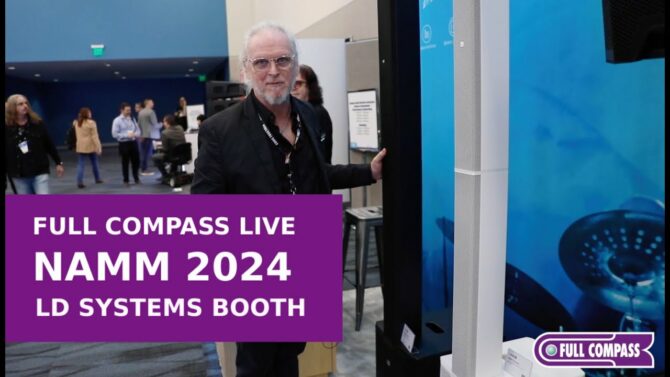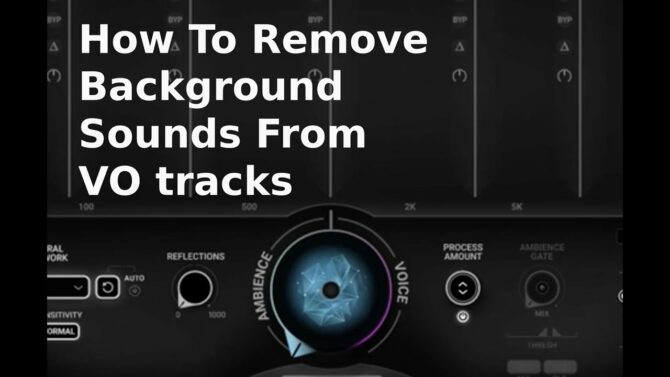Although many keyboard players consider analog Definition:
Definition:
A signal that is continuous in nature, as opposed to being defined as a series of discrete numbers (or elements) as found in digital signals; electrically "analogous" to an acoustical signal in the air. synthesizers the “gold standard” for keyboard sound quality, digital Definition:
Definition:
A signal or data expressed as series of the digits 0 and 1, typically represented by values of a physical quantity such as voltage or magnetic polarization. synthesizers generally offer more capabilities, at a lower cost. But whether for a praise band, recording session, or band performance, there are ways to obtain a more “analog” sound from digital keyboards—so let’s stretch the boundaries of digital by injecting some analog-style thinking.
Slight Tuning Variations
One of analog’s charms is the slight detuning that occurs from component values drifting due to aging and temperature fluctuations. This drift is most noticeable with multiple oscillator Definition:
Definition:
A device that generates a repeating wave or burst, used in test equipment and sound synthesis. patches, because it creates a “humanized” chorusing Definition:
Definition:
A signal processing technique that makes one instrument (or voice) sound like several instruments of the same type playing in ensemble. It does this by adding copies of the input signal with short delays, and then modulating the delay times. effect Definition:
Definition:
A device or software program that modifies some aspect of audio or video. With audio, the term is used interchangeably with signal processor.. Digital synths have inherently perfect tuning, but an easy antidote is to assign velocity Definition:
Definition:
See MIDI Velocity. and/or aftertouch Definition:
Definition:
A modulation signal added by exerting pressure on a keyboard key after it has already been pressed down. (pressure) as pitch Definition:
Definition:
For a given range of audio frequencies, pitch represents where a single sound falls within that range. modulation Definition:
Definition:
The process of one signal influencing a different signal, in real time. This can occur with radio frequencies (e.g., using audio to modulate a radio frequency carrier signal), audio frequencies (see: FM Synthesis and Ring Modulation), or sub-audio signals (see: LFO). sources (Fig. 1).
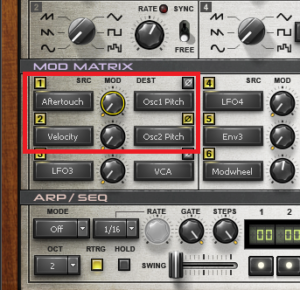
The amount should be very small—just a few cents variation. Use negative-going modulation on one oscillator and positive-going modulation on another oscillator so that one goes slightly flatter while the other goes slightly sharper. As you play, the small pitch changes will add more character. (Note: some synthesizers, like Steinberg’s Retrologue that’s included with their Cubase DAW Definition:
Definition:
(Digital Audio Workstation): A computer program or stand-alone device that provides digital audio recording, editing, and mixing., have a built-in pitch randomizing option. Although this is a more authentic-sounding option, using velocity and/or aftertouch combines randomness with a correlation to expressiveness.)
Waveform Mix and Match
Layering analog waveforms, like sine, square, sawtooth, pulse, etc. with sampled sounds can work wonders. For example, those smooth, dreamy string synthesizer sounds of the 70s were usually based on pulse and/or sawtooth waves. Layering Definition:
Definition:
Enlarging sound depth, and sometimes complexity, by combining multiple complementary sounds. these with samples of physical stringed instruments produces a result that’s smoother than the sampled version, but sounds more realistic than solely analog timbres.
Back to Mono
Many digital synths offer a monophonic Definition:
Definition:
See: Mono. keyboard mode where only one note plays at a time, just like the original Minimoog analog synthesizer. Setting the number of voices to “1” accomplishes the same result (Fig. 2). Using this mode helps get you into an analog frame of mind, and adds to the realism of analog-sounding digital patches.
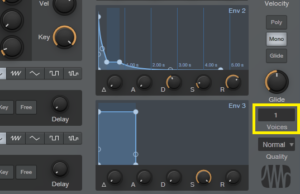
Vintage Punch
Musicians often laud the Minimoog for its “punchy” sound, but there’s some debate about what actually creates punch. So I analyzed the Minimoog’s output, and even when set for minimum attack Definition:
Definition:
The time it takes for a signal to reach maximum amplitude. This timing controls the response of dynamics processors such as compressors and limiters, and a variety of music synthesizer modules., no sustain, and instant decay Definition:
Definition:
1. The natural volume falloff in an audio or resonating system, such as reverb, or an instrument's note. 2. A parameter in an ADSR envelope. See: ADSR., the amplitude Definition:
Definition:
The volume (Amount) of a signal, electrical, optical or acoustic. envelope Definition:
Definition:
The boundary of contour of a signal over time. Example: A percussive signal has an envelope that reaches a peak instantaneously, then decays over time. exhibits a slight hold time (around 20-30 ms) at maximum level before the decay starts. I believe this is what gives the Mini its punchy sound, as it hits your ears full blast for a little bit at the beginning of the note—sort of like limiting.
With sustained sounds, you can create the same effect with any synth that has digital time/level envelopes by setting the first two levels at maximum, and the first time for about 25 ms before programming the rest of the decay. Synthesizers with a “hold” parameter (Fig. 3) make this even easier.
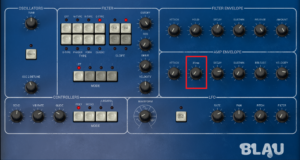
Turn Off the Chorus
Older, vintage analog synths didn’t have built-in chorus. Instead, detuning one oscillator compared to another created that sound. Granted this uses up twice as many voices compared to adding a chorus effect, but given that most digital synths have plenty of voices anyway, it’s usually worth sacrificing some polyphony for a more vintage sound quality.
Envelope Shapes
Vintage analog envelope generators usually had logarithmic slopes, as opposed to the linear slopes between levels associated with digital time/level envelopes from older digital synthesizers (Fig. 4, left). However, you can program a rate/level envelope to give a logarithmic decay. As a starting point, make each level half of the previous value, and each time twice the previous value (Fig. 4, right). While this isn’t as smooth as a true log slope Definition:
Definition:
For audio filters, the rate at which frequencies are reduced past a cutoff frequency, specified in dB/octave., it works quite well with amplitude envelopes, because the ear is relatively insensitive to level variations.

The Human Touch
Analog synths had a control for every parameter, which encouraged real-time tweaking. Digital synths (with very few exceptions) lack the same kind of control complement as analog synths, but don’t forget that many times a synth’s data Definition:
Definition:
Information used by a computer in order to arrive at a decision. Although this is a plural term, it's often treated in the singular. slider Definition:
Definition:
A portable track that allows moving a camera smoothly, typically forward and backward or left and right. can control a particular function. Also, you don’t have to use the footpedal jack Definition:
Definition:
A connector, normally female, that works in conjunction wit a plug. Usually located in a piece of equipment, or as part of a cable. for a footpedal. You can wire up a potentiometer Definition:
Definition:
A rotary or sliding electrical control, based on resistance, typically with three terminals. Rotating or sliding the control increases the resistance between a center and end terminal, while reducing resistance between the center and the other terminal. Also called Fader when applied to audio levels. See also: Resistor. in a little box, add a knob, plug Definition:
Definition:
A connector, normally male and attached to a cable. that into the footpedal jack, and use the knob to provide a real-time control option.
Unfortunately, many digital synths quantize the control settings into steps, so the sweep will not sound quite as smooth as an analog sweep—this is one area where analog synths still have undisputed sonic superiority, although the next generation Definition:
Definition:
The number of times a recording has been copied. of synths that conform to the MIDI 2.0 Definition:
Definition:
A extensive set of extensions, ratified in February 2020, that retains backward compatibility to the original MIDI 1.0 specification. Among other additions, MIDI 2.0 features bi-directional communication among MIDI devices, self-configuration, improved resolution, property exchanges among MIDI gear, and tighter timing. See also: MIDI. specification has the potential for much higher resolution Definition:
Definition:
1. (video) The measure of pixels horizontally and vertically. For example, 1920x1080 is considered HD, or high-definition. 2. (audio) The combined bit depth and sample rate of a digital audio signal.. Still, most listeners will react more to the emotional impact of the sweep itself, rather than whether or not the sweep is smooth or slightly stepped.
There are also dedicated Definition:
Definition:
Designed or used to do a specific task or set of tasks. control surfaces for synths, with the most notable being Native Instrument’s Komplete series of keyboards. They have 8 knobs and 8 switches that map to parameters in Native Kontrol Systems (NKS)-compatible Definition:
Definition:
Capable of operating with a particular selection of hardware or software. synths and effects, which are available from a variety of manufacturers. Multiple pages make it possible to map most (or even all) of a synth or effect’s parameters (Fig. 5).
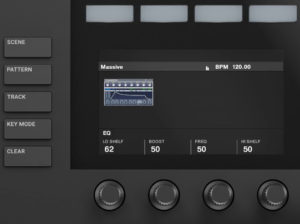
Warmer-Sounding Digital
Let’s look at why analog synths seem “warmer.” Analog synths tend to have less high end due to the signal going through a lowpass filter Definition:
Definition:
1. (audio) A circuit that reduces certain frequencies, e.g., a low-pass or high-pass filter for audio. See also: Equalizer. 2. (optics) reduces certain color wavelengths or polarizations. at all times. Even when set to the maximum highest frequency Definition:
Definition:
A value, expressed in Hertz, that indicates how many cycles of a periodic signal occur in one second. , early lowpass designs had a hard time going all the way up to 20 kHz Definition:
Definition:
Abbreviation for Kilohertz: 1,000 Hertz, or one thousand cycles per second.. Digital synths not only have a pretty extended high end, but their higher frequencies are somewhat more distortion-prone, which gives a raspy sound instead of the duller, warmer analog sound. Slightly reducing your digital synth’s highs will give a warmer sound; you can use tone controls, outboard equalizers, the simple hi-cut filters found on most mixers, etc. (Fig. 6).
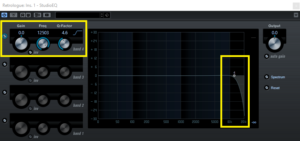
At first, the sound may seem dull by comparison, but let your ears get acclimated. Not every sound needs to have high-frequency “zing” (just ask any guitarist going through a stack of Marshalls with a Les Paul). In fact, you can often bring duller sounds up more in the mix (great for leads) without them sounding harsh or strident.
More “Animated” Sounds
Back in the early 90s, the Korg Wavestation popularized wave sequencing synthesis. The concept is that instead of layering or splitting a bunch of waveforms, you sequence them so that they play one right after the other. This produces an animated, evolving sound. While most of today’s synths and samplers may not appear to do wave sequencing, many of them can produce the same kind of effect if your keyboard can layer at least four voices, and delay Definition:
Definition:
A device that outputs and input signal some time later. This can be short for echo effects, longer for matching speaker stacks, or aligning sound and video. a note’s onset, either via envelope delay or overall voice delay. The object is to crossfade Definition:
Definition:
To transition smoothly between two sound sources. from one sound to a different sound over time, thus giving the effect of a constantly evolving sound—sort of like the way film turns individual frames into a smooth-running animation (Fig. 7).
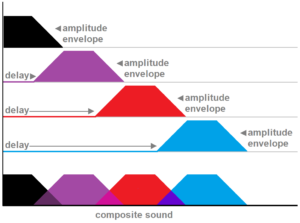
Usually, doing this in a synthesizer that doesn’t offer wave sequencing requires envelope generators with initial delay parameters (i.e., the envelope doesn’t trigger Definition:
Definition:
A signal that starts an event. until after a certain amount of time), which lets you offset Definition:
Definition:
1. A difference in timecode position between two machines. 2. A positional difference between clips in an audio or video editing program. the sounds in time. In other words, Sound A can attack and decay over 2 seconds, and after a 1 second delay, Sound B does its own attack and decay over 2 seconds. So, as Sound A fades out, Sound B fades in. Now you can add Sound C Definition:
Definition:
A non-object-oriented, procedural, higher-level computer programming language than assembly language. , which does another two-second attack and decay starting after a 2 second delay. When you play a note, Sound A crossfades with Sound B, which crossfades with Sound C.
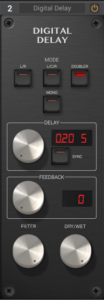
However, another method is to use delay effects. For example, IK Multimedia’s Syntronik doesn’t have an envelope delay parameter, but you can use the effects section’s Digital Delay set for delayed sound only, and no feedback Definition:
Definition:
1. A squealing, chirping, or ringing sound when a microphone feeding a loudspeaker picks up audio from that loudspeaker. Also called howlround. 2. The state where a device's output connects back to the input. (Fig. 8). This lets you delay the onset of any sound up to 4.27 seconds (the maximum delay available in Syntronik), and even better, sync Definition:
Definition:
To make two or more pieces of equipment or signals synchronize with each other. these delays to tempo Definition:
Definition:
A composition's rhythmic "pulse rate," usually specified in BPM or Beats per Minute (i.e., the number of quarter notes that occur in one minute)..
And that completes our tips for creating sounds that combine analog character with digital convenience. Don’t be a slave to the technology: learn how to use it, and you can obtain just about any kind of sound you want.









